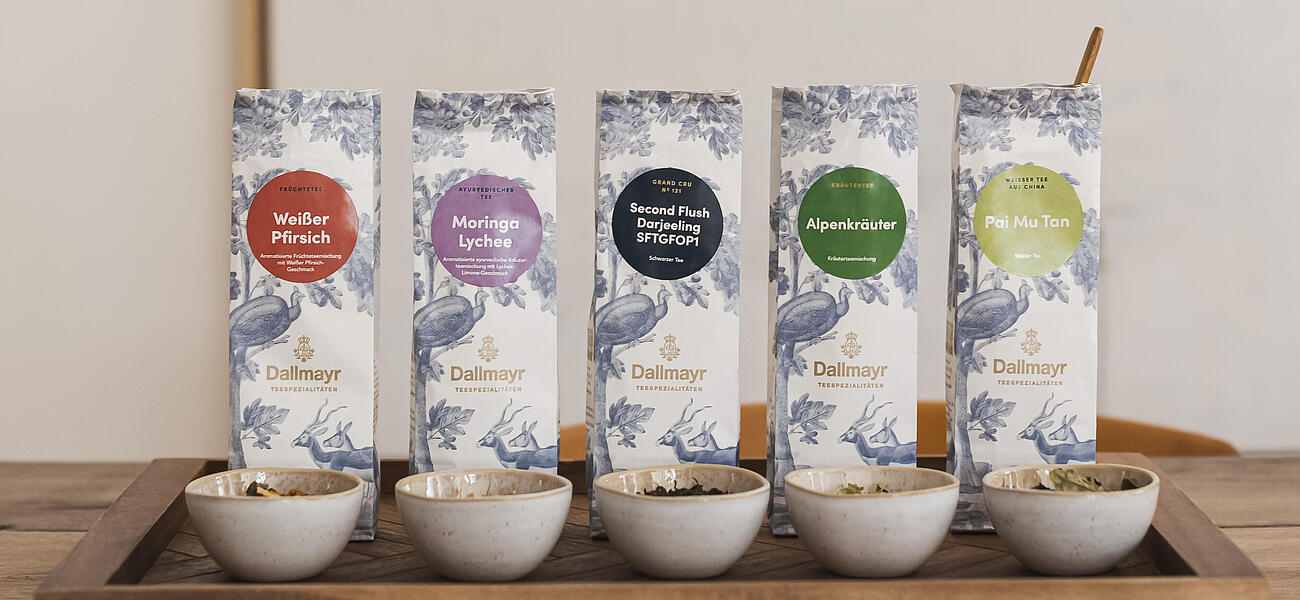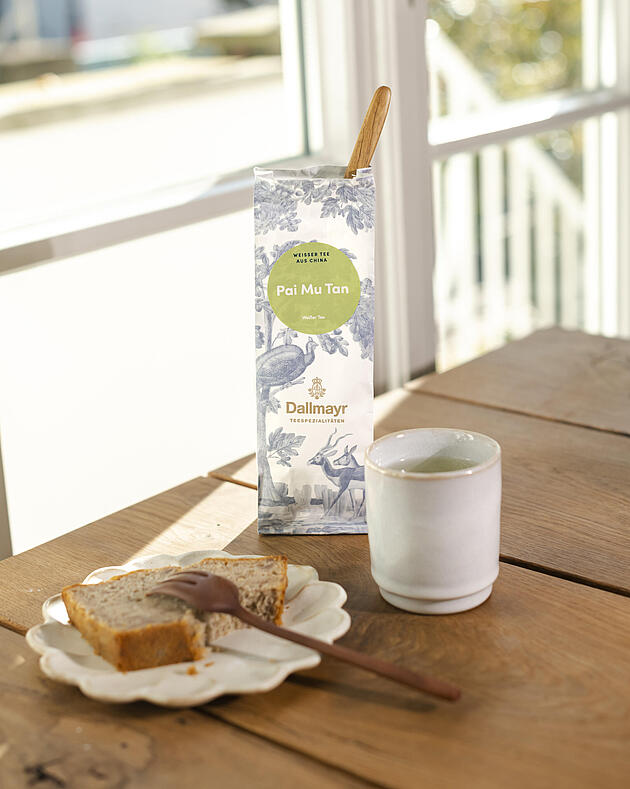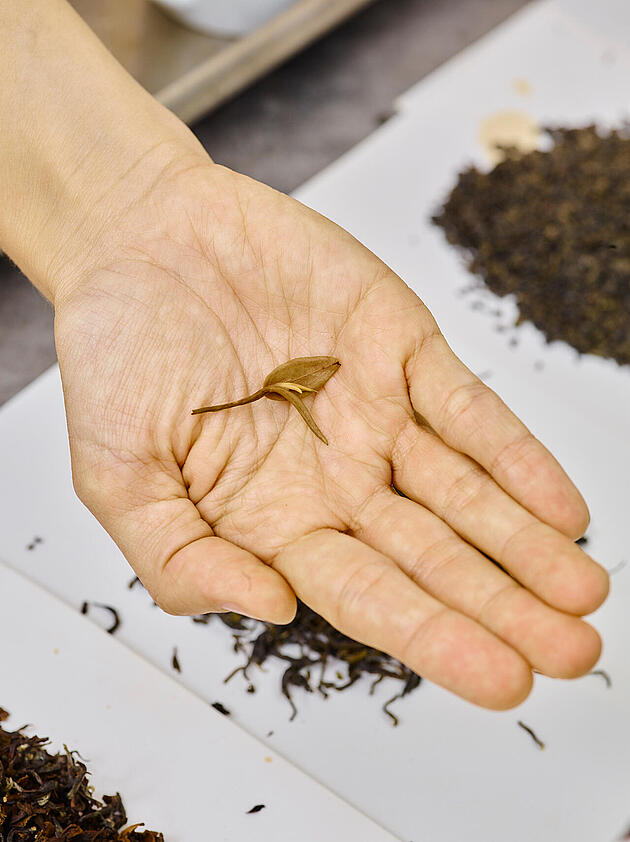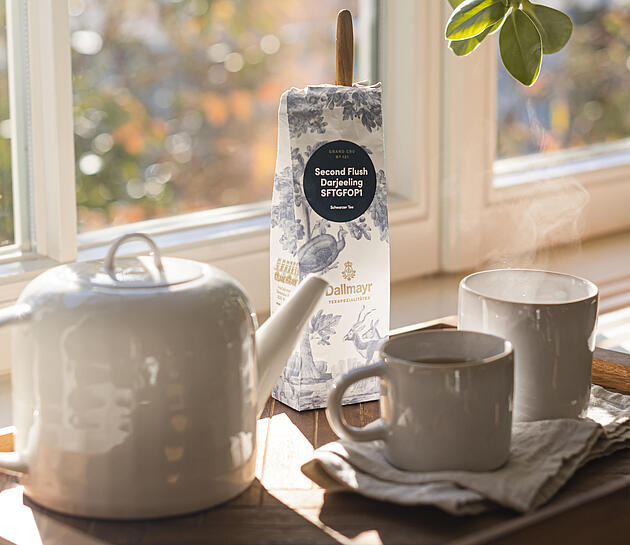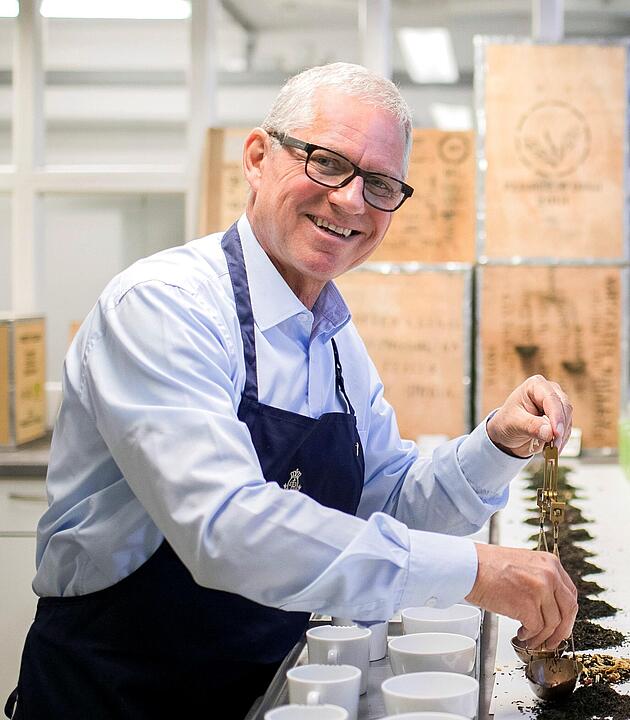“In a sense, the discovery of tea is thanks to the paranoia of a Chinese emperor,” says Rudi Krapf with a laugh. For decades, the tea expert was responsible for tasting and purchasing tea at Dallmayr – so who better to tell us some stories about this exquisite beverage? During a tea tasting, he reveals the secrets of what is probably the most popular plant in the world – from the legendary discovery of white tea to the individual nuances of green and black tea varieties.
Where did people first enjoy tea?
According to legend, white tea was discovered by chance around 5,000 years ago. “The Chinese Emperor Shennong always had his drinking water boiled because he was afraid of being poisoned,” says Rudi Krapf. One day, while his tasters were boiling his drinking water, some dried leaves from a tea bush apparently fell into the pot. “The drink gave off this delicious aroma, so they tried it,” Krapf continues. “And since tea contains caffeine, they also felt the stimulating effects.” From then on, the story goes, tea enjoyed great popularity. Today, China is still one of the “big five” tea producers – alongside India, Sri Lanka, Kenya and Indonesia.
According to Krapf, white tea is closest to tea’s pure and natural state: you pick it, dry it and then it’s ready. The white tea in the Dallmayr tea range is called Pai Mu Tan and is sourced from the mountainous region of Fujian province. “Translated, the name means ‘white peony’ because it has these white-silvery leaf tips,” explains Krapf while unfolding a rolled-up tea leaf. “If you run your hand across the tip of the leaf and over the new bud, it feels like the soft, fluffy belly of a mouse.” The motto “two leaves and a bud” sums up what’s important during the harvest. After all, it’s the first two small leaves and the fresh bud of the plant that give the drink the mild flavour and ingredients so sought-after by tea lovers.
What happens during the harvest?
Not all black and green teas are harvested in this way. However, other varieties are also highly complex to grow and produce, and tea passes through many stages before it ends up in our cups as the steaming-hot beverage we dearly love.
The CTC method is used for industrial tea production, explains Krapf. “This stands for Crushing, Tearing, and Curling. Sometimes, the tea is picked by hand, but mostly by machine. Cylindrical rollers with sharp teeth crush and separate the tea from the leaf veins, and the tea is then rolled. This creates small pellets, which can, for example, be set to a certain size for filling teabags.” Around 90% of tea production worldwide is produced using the CTC method, Krapf says. However, with just one exception, Dallmayr’s tea range contains only “orthodox” teas. “Orthodox refers to traditional production methods, which means plucking the tea by hand, withering the fresh leaves to reduce moisture content, and then rolling these leaves in the rolling machine to break down their cell structure. This exposes the leaves to oxygen in the air, which causes them to turn black.” The term “fermentation” is somewhat misleading here, as it is actually an oxidation process. Just as a piece of iron rusts in damp air or a piece of apple quickly turns brown, tea oxidises in damp air, too, and the leaves turn black. Next, the tea is spread out across large tables to form a layer around one centimetre thick, exposing it to the air. Fermentation masters assess the colour and smell to determine when the process is complete.
At this stage, the tea is still damp, so it is immediately dried at around 90 degrees Celsius. Once the residual moisture content is around 5 to 6 per cent, fermentation cannot continue. Vibrating sieves with different hole sizes then sort the tea by leaf grade, and it is now ready for export. As all leaf grades are picked from the same source, this sorting process has nothing to do with quality. It simply concerns how the tea will be used later on – will it be sold as loose tea, for example, or in teabags? “Tea picked at 7 a.m. is ready to be used at 12 noon,” says Krapf. That only applies to a single batch, of course, which often only weighs 100–150 kilos. If larger quantities of tea are required, up to 50 individual batches are often needed to create the blend. Knowing how many meticulous steps go into tea before it reaches the cup can completely transform our appreciation of the beverage.
What is First Flush and where do teas get their names?
After the winter break, the first tea is picked in Darjeeling from around mid-March. The exquisite variety produced during this period is known as “First Flush”. The first batches are exported around the world by plane immediately after processing, giving us a tea that could hardly be any fresher or more spring-like. Incidentally, Dallmayr was the first to offer this tea in Germany, in April 1959. The “Second Flush” refers to the second picking season, which lasts from around mid-May until the end of June.
Darjeeling First Flush, Darjeeling Second Flush, Ceylon and Assam: the names of these teas are still in use today and refer to their origin and harvesting period. For those who want to be particularly smart: technically speaking, the word “tea” applies only to leaves and infusions that originate from the actual tea plant. While infusions from herbs, fruits or spices are commonly called tea in day-to-day language, they are actually “tea-like products”.
What’s the difference between green and black tea?
Whether we’re talking about a white, green, black or even semi-fermented tea, they all come from the same raw ingredient: a green, freshly picked tea leaf. “With green tea, the tea plant is heated after picking – either steamed or roasted, traditionally over a fire, while turning the leaves in iron pans,” says Rudi Krapf. “This destroys enzymes in the leaves, preventing fermentation or oxidation, and the tea retains its green colour. Later on, the leaves are dried and brought back into shape.” Classic examples of high-quality green teas in the Dallmayr range include Japan Sencha and Pi Lo Chun from Taiwan.
Oolong also has special characteristics. As a semi-fermented tea, not only does it taste outstanding, but it looks great, too. “Oolong means ‘black dragon’ and gets its name because the leaves look like dragon wings,” says Krapf. “It is picked and rolled by hand rather than by machine, and is fermented for a very short period – between 20 and 30 minutes rather than the usual two hours. So if you unfold a leaf, you’ll see that the tea is somewhere between green and black. It is often fermented from the outside in – meaning that the heart of the leaf is still green and the outer edges brown.” This elaborate processing method gives the oolong its striking, slightly bready flavour. Its floral notes come from the peach trees that stand between the tea bushes to provide shade, and whose pollen settles on the tea leaves.
Does preparation affect the palatability of tea?
In his role as an expert tea taster, Rudi Krapf has given his fair share of talks on the palatability of tea – and has even been awarded the “Goldenes Teeblatt” (Golden Tea Leaf award) for his services. And one thing he’s certain about is that tea is good for your health. His job involved tasting around 300 cups of tea a day, and he is absolutely convinced that the drink is healthy, palatable and refreshing. You should of course avoid drinking too much caffeine, but Krapf also corrects a common misconception in this regard: “When it comes to the colour differences in green and black tea, they start at a light green and get darker and darker. It’s easy to assume that the darker teas are stronger and contain more caffeine, but the opposite is actually the case. The smaller and younger a tea leaf, the higher its caffeine content, as the tea plant uses caffeine to protect the younger shoots from pests. The older the leaves, the harder and more leathery they become, and the less interesting they are to insects. So, the caffeine breaks down over time. That’s why delicate, flowery teas made up predominantly of tips often contain more caffeine than full-bodied, darker varieties.”
